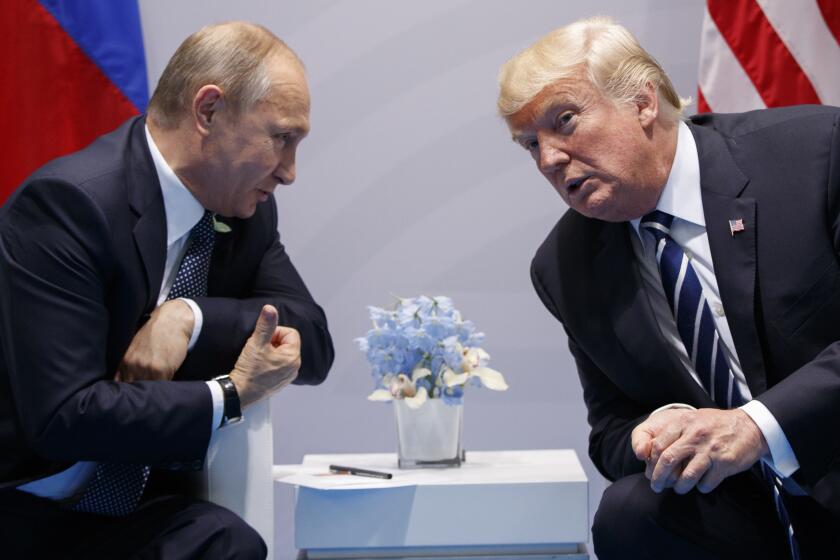War Planners Sketch Strategy for Desert Fight
- Share via
WASHINGTON — President Bush’s plan for blocking an Iraqi invasion of Saudi Arabia combines a deployment of American ground troops with sophisticated air and naval weaponry designed to shatter advancing armored columns in the desert wastes of the world’s richest oil fields.
Even if they were unable to match an Iraqi invasion force tank for tank and man for man, U.S. military forces would seek to dominate the battle from the skies, raining down Maverick missiles and explosive mines on Iraqi tanks and infantry.
As sketched by U.S. military planners, a modern desert war would see sophisticated fighters capitalizing on air superiority while naval guns bombard a strategic coastal road and paratroopers dig in at crucial choke-points to erect anti-tank defenses.
Such a battle would be costly to both sides. But, while it would be unlikely to send Iraqi President Saddam Hussein and his forces fleeing, it at least would “soak up” Iraq’s onslaught and “probably stop” any Hussein advance, a senior military official said.
The specter of such a conflict--involving some of the most elite troops and warplanes that the United States can muster--provides at last what American officials say is a credible deterrent that makes it clear any Iraqi land grab would be met with significant force.
But with Iraq’s 1-million-man army dominating the region, there still is major uncertainty about Hussein’s intentions. Although the increased air power might protect Saudi Arabian soil, experts said, it offers no hope of forcing the enemy to roll back from Kuwait.
“This is an important step, but it don’t get Kuwait back,” Michael Dunn, a Washington-based military consultant, said.
Indeed, military planners said Tuesday that the single most important facet of the U.S. intervention may be the actual presence of Americans on the ground--an unmistakable tripwire that virtually guarantees that any new Iraqi foray would bring the United States to war.
They noted that with Tuesday’s troop deployments, America’s once-vague threat of retribution had now been rendered immediate and vivid. The airborne weapons Bush sent to Saudi Arabia on Tuesday can halt even the most well-armored tank.
“Deterrence means control of the other side’s state of mind--and this is bound to get Hussein’s attention,” retired Navy Adm. Thomas Moorer said.
Air Force experts said that with access to Saudi air bases, which has now been granted, U.S. warplanes could stall and exact heavy losses on any Iraqi ground attack--even a blitzkrieg that sent hundreds of tanks thundering down the highway toward the Saudi oil port of Dhahran.
Under a scenario described by several military sources, such an attack would be scouted out in advance by high-flying TR-1 spy planes and blunted from its outset by super-secret Navy EA-6B Prowlers, whose electronic arsenal could confound enemy communications.
Almost immediately, Air Force planes and Navy vessels in the Persian Gulf would bombard the coastal roadway, forcing Iraqi columns into the sand. Tank-killing F-16s and AH-64 Apache helicopters would join in the attack, firing Maverick and Hellfire missiles.
Any Iraqi breakdown would quickly be compounded as tanks bogged down in traffic and became more vulnerable to airborne raids.
“That terrain is very hard to hide tanks in,” one Pentagon war-planner said. “They would look like a fleet of ships floating out in a big, featureless desert.”
At the same time, American and Saudi ground forces, dug in at crucial points and armed with thousands of antitank weapons, would fire additional salvos at the narrow spaces where increasingly unfriendly Saudi Arabian terrain would force the tanks into a single file.
“You could delay them, you could stop them, you could hurt them badly,” said Benjamin Lambeth, a former combat fighter pilot who is now a RAND Corp. consultant and expert on tactical air forces.
“What you’re dealing with is a situation in which U.S. air assets would be used as a spoiling factor, with a view to making any such operations prohibitively costly,” Lambeth added. “And the sooner you have them there, the easier it is to do this.”
To be sure, Pentagon planners caution that military operations are inherently uncertain, and often even the best-laid plans do not work out. Moreover, they concede that U.S. forces have little experience in desert warfare, particularly against troops like the war-hardened Iraqis.
Nevertheless, strategists say that the size and type of the force that the President has ordered deployed makes the prospect that the mission might succeed a credible threat to Iraqi commanders--and that in itself may be sufficient to forestall any new attack.
The optimistic scenario envisions U.S. aircraft quickly assuming control of the skies, leaving American fighters and helicopters free to strafe oncoming armored forces without fear of being blindsided from the air.
In such early dogfights, early-warning radar surveillance planes operated by Saudi forces would play a crucial role in managing the battle from the air. But experts warned that despite the presence of the AWACS planes, the air battle still might bring heavy casualties.
Top-of-the-line Air Force fighters, such as F-15s and older F-111s, would joust with advanced Soviet-made MIG-23s, flown by Iraqi pilots whose skill and experience makes them among the most feared flyers in the Middle East.
And even if the American forces prevailed aloft, they would still have to contend with French-made Mirages and tank-protecting Iraqi aircraft called Su-25 “Frogfoots.” Among the planes that the Frogfoots would have to face: RF-4 reconnaissance/attack planes that the Air Force calls Wild Weasels.
“This is not a fight that we’re looking for,” one Pentagon planner said. “But those forces are ready to go to war today.”
If the defensive effort foundered--or perhaps even if it did not--American forces might well respond by widening the battlefield and striking deep into Iraqi territory at supply depots and airfields, the military analysts said.
Among the weapons that might be brought to bear: A-6 Intruders and A-7 Corsairs from American carriers, F-111s based in Turkey or even long-range B-52s now believed to be in the Indian Ocean--any of which could attack behind Iraqi lines.
But the more likely assault would come from Tomahawk cruise missiles, armed with conventional explosives and launched from Navy vessels from as far as 1,600 miles.
“There is no doubt in my mind that we would blow the hell out of every airfield in Iraq,” said one retired Army general, who insisted on anonymity.
Iraq has one of the best air defense networks in the world, military analysts say.
Added Moorer, the retired Navy admiral: “This is all just part of deterrence, to make Hussein stop and think.”
RELATED STORIES: A8 through A12, D1, D6, D7 and E1
More to Read
Sign up for Essential California
The most important California stories and recommendations in your inbox every morning.
You may occasionally receive promotional content from the Los Angeles Times.











